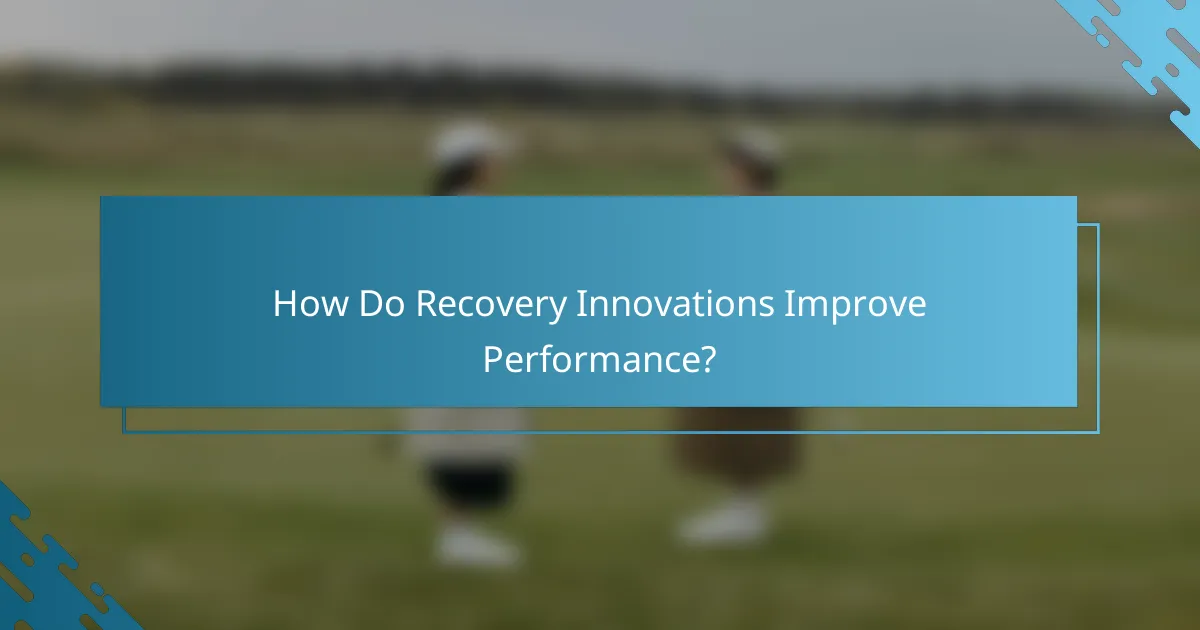Innovative recovery technologies are transforming the way athletes and active individuals enhance their performance and well-being. By focusing on the body’s natural healing processes, these methods not only alleviate soreness and reduce inflammation but also significantly improve recovery times. With advancements in data utilization and materials, personalized recovery solutions are now more accessible, leading to better muscle repair and flexibility while minimizing injury risks.

What Are the Most Effective Recovery Technologies?
The most effective recovery technologies focus on enhancing the body’s natural healing processes. These methods can alleviate soreness, reduce inflammation, and improve overall recovery times for athletes and active individuals.
Cryotherapy
Cryotherapy involves exposing the body to extremely cold temperatures to promote recovery. This technique can reduce inflammation, numb pain, and enhance muscle recovery after intense workouts.
Typically, cryotherapy sessions last between 2 to 4 minutes, and temperatures can drop to around -110°C to -140°C. Athletes often use whole-body cryotherapy chambers or localized ice packs for targeted relief.
Hydrotherapy
Hydrotherapy utilizes water for pain relief and rehabilitation. This method can include hot baths, cold plunges, or aquatic exercises, each providing unique benefits for muscle relaxation and circulation improvement.
For instance, warm water can soothe sore muscles, while cold water can reduce swelling. Sessions can vary from 15 to 30 minutes, depending on the specific treatment and individual tolerance.
Electrical Stimulation
Electrical stimulation therapy uses electrical impulses to stimulate muscles and nerves, promoting recovery and pain relief. This method can enhance blood flow, reduce muscle spasms, and support rehabilitation efforts.
Devices like TENS units are commonly used for at-home treatment, while professional settings may employ more advanced equipment. Sessions typically last 20 to 30 minutes, and users should follow guidelines to avoid overstimulation.
Compression Therapy
Compression therapy involves applying pressure to limbs to improve circulation and reduce swelling. This technique is often used post-exercise to speed up recovery and decrease muscle soreness.
Compression garments, such as sleeves or socks, can be worn during or after workouts. Alternatively, pneumatic compression devices can provide adjustable pressure and are typically used for about 30 minutes to an hour.
Active Release Techniques
Active Release Techniques (ART) are manual therapy methods that focus on releasing tension in muscles, fascia, and nerves. Practitioners apply specific pressure while guiding the patient through movements to target tight areas.
ART sessions usually last around 30 minutes and can be tailored to individual needs. This technique is particularly beneficial for athletes recovering from injuries or chronic pain conditions, promoting flexibility and range of motion.

How Do Recovery Innovations Improve Performance?
Recovery innovations enhance performance by optimizing the body’s healing processes and reducing downtime. These technologies leverage data and advanced materials to provide personalized recovery solutions that can lead to improved athletic performance and overall well-being.
Wearable Technology
Wearable technology, such as fitness trackers and smartwatches, monitors key physiological metrics like heart rate, sleep patterns, and activity levels. By analyzing this data, users can identify when they need rest or when they are ready to push harder, ultimately improving recovery times.
Popular devices include the Fitbit and Apple Watch, which offer insights into recovery through features like heart rate variability and sleep quality tracking. Users should ensure their wearables are comfortable and accurate for the best results.
AI-Driven Recovery Apps
AI-driven recovery apps provide personalized recovery plans based on user data and preferences. These applications analyze performance metrics and suggest tailored exercises, nutrition plans, and rest periods to optimize recovery.
Examples include apps like Whoop and TrainHeroic, which adapt recommendations based on real-time feedback. Users should regularly input their data for the app to generate the most effective recovery strategies.
Smart Fabrics
Smart fabrics integrate technology into textiles to enhance recovery through compression, temperature regulation, or biofeedback. These materials can help improve circulation and reduce muscle soreness, facilitating quicker recovery post-exercise.
Products like compression garments and heated recovery suits are becoming popular among athletes. When choosing smart fabrics, consider factors such as breathability, comfort, and the specific recovery benefits they offer to ensure optimal performance enhancement.

What Are the Benefits of Advanced Recovery Methods?
Advanced recovery methods offer significant advantages, including faster recovery times, improved muscle repair, and enhanced flexibility. These benefits contribute to better overall performance and reduced risk of injury for athletes and active individuals.
Reduced Recovery Time
Advanced recovery methods can significantly shorten the time needed for muscles to recuperate after intense workouts. Techniques such as cryotherapy, compression therapy, and infrared saunas help reduce inflammation and promote blood flow, leading to quicker recovery.
For example, athletes using cryotherapy may experience a reduction in recovery time by up to 50%, allowing them to train more frequently and effectively. Incorporating these methods into a regular routine can help maintain peak performance levels.
Enhanced Muscle Repair
These recovery techniques promote muscle repair by increasing circulation and delivering essential nutrients to damaged tissues. Methods like electrical stimulation and massage therapy can help accelerate the healing process and reduce muscle soreness.
Utilizing these methods post-exercise can lead to improved muscle recovery, enabling athletes to return to training sooner. Regular use can also prevent long-term damage and enhance overall muscle health.
Improved Flexibility
Advanced recovery methods can enhance flexibility by reducing muscle tightness and increasing range of motion. Techniques such as dynamic stretching, foam rolling, and yoga can effectively loosen muscles and improve overall flexibility.
Incorporating these practices into a recovery routine can lead to better performance in sports and daily activities. Regular flexibility training can also help prevent injuries and promote long-term joint health.

What Criteria Should You Consider When Choosing Recovery Technologies?
When selecting recovery technologies, consider effectiveness, cost, and accessibility. These criteria will help you determine the best solutions for your specific recovery needs and ensure that you achieve optimal results.
Effectiveness
Effectiveness refers to how well a recovery technology restores data or system functionality. Assess the technology’s track record, including success rates and recovery times, to ensure it meets your requirements. For instance, some solutions may recover data within minutes, while others might take hours or longer.
It’s also essential to evaluate the types of data or systems the technology can recover. Some may specialize in specific file types or systems, while others offer broader capabilities. Choose a solution that aligns with your data environment to maximize effectiveness.
Cost
Cost is a critical factor when evaluating recovery technologies. Prices can vary widely, from low-cost software solutions to high-end enterprise systems. Consider both initial costs and potential ongoing expenses, such as subscription fees or maintenance costs.
To make an informed decision, compare the costs against the effectiveness and features offered. Sometimes, investing in a more expensive solution may save money in the long run by reducing downtime and data loss.
Accessibility
Accessibility involves how easily users can implement and utilize the recovery technology. Look for solutions that offer user-friendly interfaces and comprehensive support resources. This can significantly reduce the learning curve and improve recovery efficiency.
Additionally, consider whether the technology is available on various platforms or devices. Solutions that work across different operating systems or cloud environments can provide greater flexibility and convenience for users.

What Are the Local Variants of Recovery Technologies?
Local variants of recovery technologies refer to the different methods and innovations tailored to specific regions, considering local resources, regulations, and needs. These technologies can vary significantly based on geographical, economic, and cultural factors, impacting their effectiveness and adoption.
Regional Availability
Recovery technologies are often influenced by regional availability, which includes the local infrastructure, resources, and regulatory environment. For instance, in Europe, countries like Germany and Sweden have advanced recycling and waste-to-energy systems, while other regions may rely more on traditional landfill methods.
In North America, recovery technologies such as anaerobic digestion and advanced composting are becoming more prevalent, particularly in urban areas where waste management is a priority. Local governments often provide incentives for adopting these technologies, which can vary widely from one state or province to another.
To assess the availability of recovery technologies in your area, consider checking local government resources or industry reports that outline the technologies in use and any upcoming innovations. This can help you understand what options are feasible and beneficial for your specific context.
